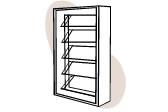
- Have a series of blade that tilt to open
- Opened by handle, lever or remote control
- Blades can be made of glass, aluminium and timber

What are louvres?
Louvre windows (or just ‘louvres’, as they’re more commonly known) are a common choice in some parts of Australia because they’re stylish, versatile and can help to naturally ventilate your home. These types of window openings are particularly popular in the tropical northern regions of Australia where they’re valued for the excellent cross-ventilation they can help to provide.
Louvres are comprised of a series of horizontal pieces of wood, glass, aluminium or other material fitted to the window frame, which may be adjusted to rest open to allow light and breeze through, or closed to completely resist the elements. Louvre slats are generally adjusted by a simple pulley or lever system used by the user.
Louvres are also known as louvers, jalousie windows and shutters, depending on where in the world you’re from.
How are louvres used?
Traditionally, louvres were used in places like kitchens where they could be left open to allow for ventilation while keeping out light rain – and they’re still very popular for the same reason in the tropics, where the humidity may otherwise make closing the windows uncomfortable.
Louvres offer significantly greater areas through which to ventilate the house than most other types of windows, and a lot of homes incorporate louvres on either side of the house to allow large volumes of air to flow straight through. When closed, louvres can offer a decent seal, and many incorporate some sort of locking mechanism. How much insulation louvres provide when they’re closed will depend on how effectively they’re sealed closed and what types of materials are used.
Louvres can be incorporated into both modern and more traditional styles of construction, and are often fitted with flyscreens or security screens. As with other windows, different types of glass and glass treatments can be used to help control heat gain and loss – tinted glass can help reduce solar heat gain, while in cool climates you can install low e-glass to reduce heat loss.
Louvres can also be designed into the interior of a house to help control and improve cross ventilation, and to allow more light into otherwise dark recesses. Louvres take up very little horizontal and vertical space, and as such they’re a practical choice as an internal window.
Louvre installation and sizes
Louvres don’t require any particularly complex installation, although they do come in different sizes and configurations, normally designed to conform to standard window sizes. Some of the variables you’ll need to consider include:
- what materials your louvres will be made of
- what colour your louvres will be
- what sorts of mechanisms will be used to open and close them
- how wide the louvre blades will be
- how high the louvre blades will be
- how many louvre blades you’ll have per bay (i.e. how many in each rows of louvres)
- how tall your louvre bays will be
- how many bays of louvres you’ll have in each configuration (e.g. two bays = two rows, four bays = four rows)
- whether your louvres will need weather stripping to kee the elements out
Where a particular configuration of blades doesn’t fit perfectly into the allotted space, a fixed, non-standard sized blade is often installed at the top of the bay to fill the difference. Louvres should be constructed and installed to adhere to the Australian Standard AS 2047-1999, Windows in buildings – Selection and installation.
It’s worth noting that louvres are pretty easily compromised from the outside if they’re left open. A firm push will normally dislodge the blades and allow people to break in, so depending on where they’re being installed, adding some bars or security screens may be a good idea.
Maintenance tips
Another advantage of louvre windows is that they’re far easier to keep clean than many other types of windows. Both sides of the louvre blades can be cleaned from inside, which makes them a practical choice for elevated or multi-storey houses.
|
Advantages
|
Disadvantages
|





